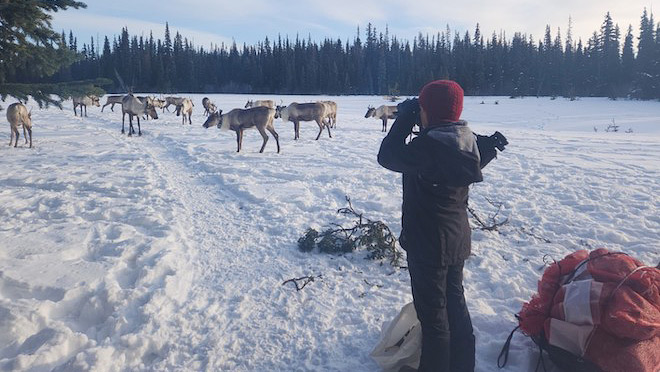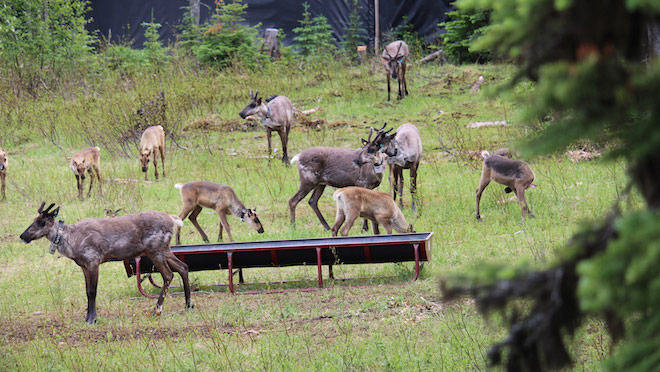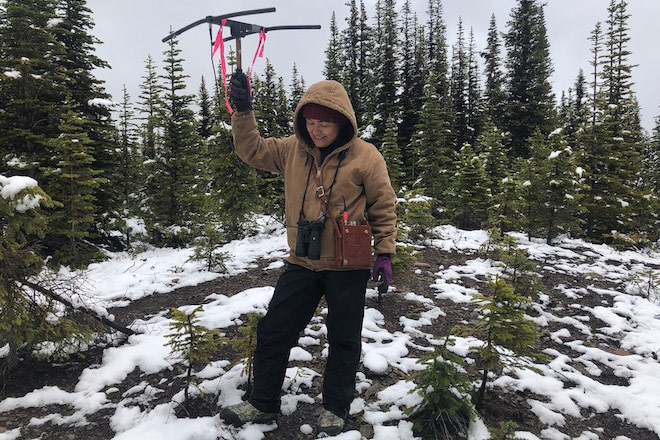Indigenous guardians help triple size of B.C. caribou herd

Maternity pen for pregnant caribou and their offspring boosts survival odds
Feed and protect, but don't touch. The Indigenous guardians of the Klinse-Za caribou herd in northern B.C. take great care to ensure that, even after months in a maternity pen that serves as protection from predators, woodland caribou and their offspring head into the forest very much the wild animals they're meant to be.
"We still really, really try our best to treat them as wild animals," says Starr Gauthier, a guardian from the Saulteau. "We don't get very close, of course, and we never touch them, except when we first capture the calves and collar them. If they get close to us when we're feeding them, we kind of shoo them away."
In the 1970s, the elders of the Saulteau and West Moberly First Nations noticed how much the caribou herd had shrunk. Habitat destruction, in large part through resource extraction and hydroelectric development, had put the Klinse-Za caribou herd – which had been a key food and cultural force for local First Nations – in danger of "extirpation", the technical term for erasure.
Over the past decade, bans on hunting the caribou (self-imposed by the Nations long before they became law in B.C.), and an Indigenous-led effort to capture, protect and nourish pregnant caribou and their offspring for a greater chance at survival, have tripled the herd to around 132. The Saulteau and West Moberly Nations-led caribou maternity pen initiative is the most successful program of its kind in Canada. It’s an example of the trend toward co-management of natural resources with Indigenous Peoples, who have tenure rights to over one-quarter of the world's land.
While the program relies on a variety of funding sources, BC Hydro has provided about $750,000 through the Fish & Wildlife Compensation Program (FWCP) over the past five years to helping bring the Klinse-Za caribou herd back. For 2023-2024, the FWCP – which conserves and enhances fish and wildlife in watersheds impacted by BC Hydro dams – is supporting 89 projects across three B.C. regions for a total of $10.2 million. Projects range from improving access to fish habitat in the Squamish estuary, to conserving and enhancing habitat for at-risk bank and barn swallows in the Columbia Region.
For Gauthier, who says she felt conflicted while working in the past on conservation initiatives for oil, gas, and mining companies, the role of Indigenous steward for the caribou is uniquely rewarding.
"I'm drawn to the mountains," she says. "So when this opportunity came up, it was like one in a million. I'm extremely grateful and still in awe of this project."

Caribou were so numerous, 'like bugs on the landscape'
On a program update Zoom call in April, caribou recovery program lead Landon Birch pointed to a spot on a map in north central B.C. where the Klinse-Za herd are part of central mountain group of southern mountain caribou.
"When speaking with elders from the West Moberly and Saulteau First Nations, they described caribou as once being so abundant in this area that they were like bugs on the landscape," says Birch. "It was like a sea of caribou, and they were a really important food source for these Nations.
"It was this connection to the herd that made them aware that something was wrong, that the numbers weren't quite right. But it wasn't until the 1990s that official surveys started to document a decline in the area."
One estimate put the number at 36 in the herd in 2013, down from a high of over 200 decades earlier.
Birch explained that there were a variety of factors that contributed to putting the Klinse-Za herd on the brink of extirpation. One was the construction of the WAC Bennett Dam, which created a reservoir that disrupted some of the caribou's migratory pathways.
The recovery program was designed to try to rehabilitate key areas of habitat – through measures such as deactivating and reforesting a section of forest service road – while also controlling a growing wolf population that was reducing the caribou's chances of survival. But it's the maternity pen located on Mount Bickford, about 60 km west of Chetwynd that's proving most vital. It's helping ensure caribou calves are strong and fast enough to avoid predators including wolves, grizzlies and wolverines, before they're released to the wild.

Helicopters used to transport captured caribou
In the context of the recovery program, caribou females are more important than males. But for reasons not yet entirely understood, only 42% of Klinse-Za calves have been female.
The good news is that the caribou are very fertile, so the program captures as many females as possible each spring, knowing that more than 90% will be pregnant. This past March there were a record 21 cows including 20 that arrived pregnant.
The program uses snowmobiles and helicopters to round up the females, bagging them and then carrying them in helicopters anywhere from two to 60 km away to the maternity pen.
"We bag them up in a [specially designed] bag, so that they can't hurt themselves," says Birch. "And we only capture cows within their herd area. We're not going outside to different herds. Once we get them to the pen, the real work starts."
Initially, the cows are fed one of their favourite foods, lichen, which is gathered by program staff. They can also wander the pen, which measures about 10 hectares, to forage for food on their own. But eventually, they're fed nutrient-rich pellets designed to strengthen them for birth.
The pen is protected by two outer electrified fences and a third, internal fence built of landscaping fabric and tall enough to repel leaping predators and crucially aimed at blocking predators' view of the caribou.
"It's a visual barrier fence that's designed to prevent a predator from switching to a chase mentality," says Birch. "Cats and other animals see something move, and chase mode kicks in. If a bear or other large predators saw a caribou in the pen, I very much doubt that the electric fence, would stop them."
Sets of two guardians live in a rustic cabin at the pen for seven days, then return to their homes and are relieved for a week by two other guardians before returning the next week. This rotation – Gauthier and Draydon Field of the Saulteau exchanging with Corbin Brown and Kendall Davis from West Moberly – continues March through July or the early weeks of August, with the guardians feeding, patrolling for predators, and mending fences.
Gauthier carries a gun, but doesn't often need it. While wolverines tough enough to shrug off the shock of an electric fence have been spotted on the pen's cameras, their progress ends at the high internal fence. Black bears are spotted, but rarely are grizzlies around.
"Well, grizzlies are smart," says Gauthier. "They don't like us. and that's good. The first couple of years of the pen, they were coming around. And about six years ago, a grizzly bear came and bit the electric fence, and I think he never came back. But in the five years I've been there, I haven't had a run in with a grizzly."
The caribou cows and calves aren't released from the pen until the youngest calf is at least seven weeks old and the immediate area is clear of predators. All the caribou are fitted with collars – designed to adjust as the young caribou grow and their necks get bigger – that allow them to be tracked with GPS.
Near the end of the project update call, Birch stresses how hard the guardians work at the pen, making "pretty significant sacrifices" to keep the program going. There's also an appeal for more funding from Blake Spencer, the program's habitat restoration lead, money he says is vital to ensuring the ongoing survival of the Klinse-Za herd.
Related: